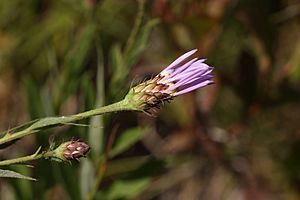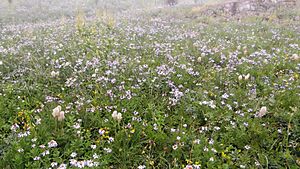Cascade aster facts for kids
Quick facts for kids Cascade aster |
|
|---|---|
 |
|
| Dark Divide in Washington | |
 |
|
| Mount Rainier National Park | |
| Conservation status | |
| Scientific classification | |
| Kingdom: | |
| (unranked): | |
| (unranked): | |
| (unranked): | |
| Order: | |
| Family: | |
| Tribe: |
Astereae
|
| Genus: |
Eucephalus
|
| Species: |
E. ledophyllus
|
| Binomial name | |
| Eucephalus ledophyllus (A. Gray) Greene
|
|
| Synonyms | |
|
|
The Cascade aster (scientific name: Eucephalus ledophyllus) is a beautiful flowering plant. It belongs to the aster family, which is a very large group of plants. You can find this plant growing in North America.
It is native to the western parts of the United States. Specifically, it grows in Washington, Oregon, and northern California. Most of these plants live in the Cascade Mountains. Some populations are even found inside famous national parks. These include Mount Rainier National Park and North Cascades National Park. You can also see them at Mount St. Helens National Volcanic Monument.
What Does the Cascade Aster Look Like?
The Cascade aster is a type of perennial herb. This means it lives for more than two years. It grows back each year from its roots. The plant can reach a height of up to 80 centimeters (about 32 inches). It has a strong, woody base called a caudex. This caudex helps the plant survive and grow year after year.
Its Flowers
One Cascade aster plant usually produces many flowers. It can have anywhere from 3 to 20 flower heads. These flower heads are very colorful and easy to spot. Each flower head has two main parts.
- Ray florets: These are the outer petals that look like rays. On the Cascade aster, they are a pretty purple color.
- Disc florets: These are the tiny flowers in the center of the head. They are usually yellow on this plant.
Together, the purple ray florets and yellow disc florets make the Cascade aster a very attractive flower.
Types of Cascade Aster
There are two main types, or varieties, of the Cascade aster. They are very similar but have a small difference in their stems.
- Eucephalus ledophyllus var. covillei: This variety grows in Oregon and California. Its flower stalks do not have a cottony or fuzzy feel.
- Eucephalus ledophyllus var. ledophyllus: This variety is found in Washington and Oregon. Its flower stalks are covered in a soft, cottony fuzz.


